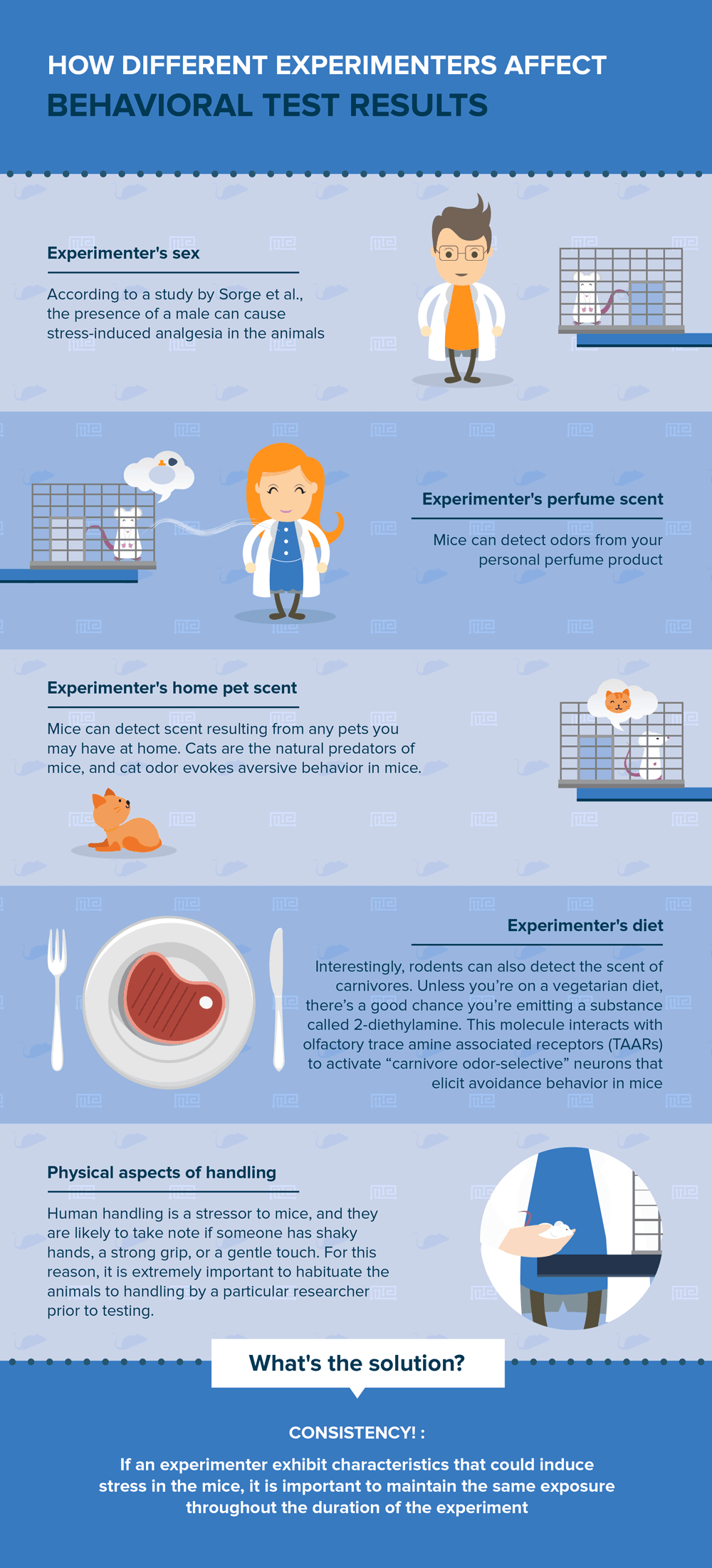Behavioral testing can be incredibly time consuming, sometimes continuing for weeks at a time without a single day off. In this circumstance, it might be tempting to ask a lab mate to fill in for you for a day or two to give you a break from testing. But is this a bad idea? Will your mice or rats even know the difference?
The short answer is YES! Experimental outcomes can be affected by differences in the personnel administering behavioral tests. This is driven in large part by the very sensitive rodent’s nose, which allows mice to distinguish a variety of interesting traits about their handlers based on odorant cues that are largely undetectable by humans[1].
The first of these traits is the sex of the experimenter, which has been shown to profoundly affect the stress levels and behavior of mice. A fascinating study by Sorge et al. showed that mice were less sensitive to a painful stimulus when it was administered by male researchers[2]. Further tests showed that the mice had increased levels of the stress hormone corticosterone while in the presence of men. This suggested that the presence of a male caused stress-induced analgesia in the animals[3].
In other words, human male odor stresses the mice out. This effect was elicited by the mere presence of a male’s t-shirt in the room. Since stress is known to affect a range of behaviors in addition to pain, including emotion-related behaviors and cognitive function, experimenter sex is likely to have a huge impact on behavioral test results.
Before all the male grad students start celebrating that they’re off the hook for behavioral testing, this doesn’t mean that male researchers can’t perform behavioral tests, but the effect of this variable on basal stress levels and test outcomes should be considered. Dr. Jeffrey Mogul, who led the pain study, has suggested that information regarding the sex of the experimenter(s) should be included in the experimental section of manuscripts[4].
In addition to detecting your sex, mice can also detect odors from your personal products such as perfumes, those resulting from any pets you may have at home, and even odors related to your diet. For instance, cats are the natural predators of mice, and cat odor evokes aversive behavior in mice[5]. So if you have a pet cat at home, trace odors in your clothing might evoke changes in rodent stress responses.
Interestingly, rodents can also detect the scent of carnivores. Unless you’re on a vegetarian diet, there’s a good chance you’re emitting a substance called 2-diethylamine. This molecule interacts with olfactory trace amine associated receptors (TAARs) to activate “carnivore odor-selective” neurons that elicit avoidance behavior in mice[6].
In addition to odorant cues, mice can sense other differences between researchers, such as the physical aspects of handling. Human handling is a stressor to mice, and they are likely to take note if someone has shaky hands, a strong grip, or a gentle touch. For this reason, it is extremely important to habituate the animals to handling by a particular researcher prior to testing.
What is the takeaway? While it’s probably not a good idea to use Chad the cat-loving undergrad with the twitchy hands to run your behavioral tests, the more important point is that consistency is critical. If an experimenter does exhibit characteristics that could induce stress in the mice, it is important to maintain the same exposure throughout the duration of the experiment. For example, although it is advisable to avoid scented products altogether, if you wear perfume on Day 1 of testing, you need to wear the same scent on all subsequent testing days. Animals can adapt to the subtle cues that indicate a particular person is performing a test, and it is important to avoid any personnel changes mid-experiment.
References
- Bind RH, Minney SM, Rosenfeld S, Hallock RM. (2013) The Role of Pheromonal Responses in Rodent Behavior: Future Directions for the Development of Laboratory Protocols. J Am Assoc Lab Anim Sci. 52(2):124-9.
- Sorge RE, Martin LJ, Isbester KA, Sotocinal SG, Rosen S, Tuttle AH, Wieskopf JS, Acland EL, Dokova A, Kadoura B, Leger P, Mapplebeck JC, McPhail M, Delaney A, Wigerblad G, Schumann AP, Quinn T, Frasnelli J, Svensson CI, Sternberg WF, Mogil JS. (2014) Olfactory exposure to males, including men, causes stress and related analgesia in rodents. Nat Methods. 11(6):629-32.
- Butler RK1, Finn DP. 2009 Stress-induced analgesia. Prog Neurobiol. 88(3):184-202.
- Grimm D. (2014) Animal research. Male scent may compromise biomedical studies. Science. 344(6183):461.
- Ferrero DM, Lemon JK, Fluegge D, Pashkovski SL, Korzan WJ, Datta SR, Spehr M, Fendt M, Liberles SD. (2011) Detection and avoidance of a carnivore odor by prey. Proc Natl Acad Sci U S A. 108(27):11235-40.
- Papes F, Logan DW, Stowers L. (2010) The vomeronasal organ mediates interspecies defensive behaviors through detection of protein pheromone homologs. Cell. 141(4):692-703.

